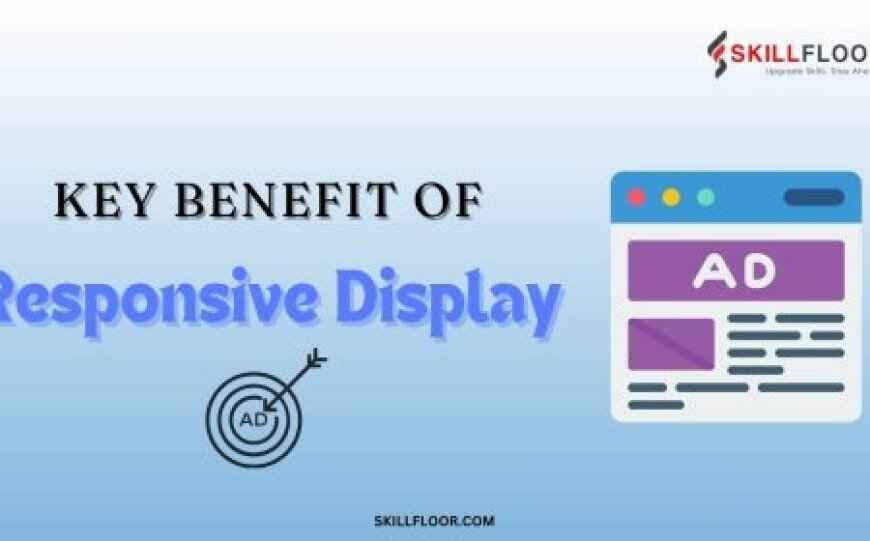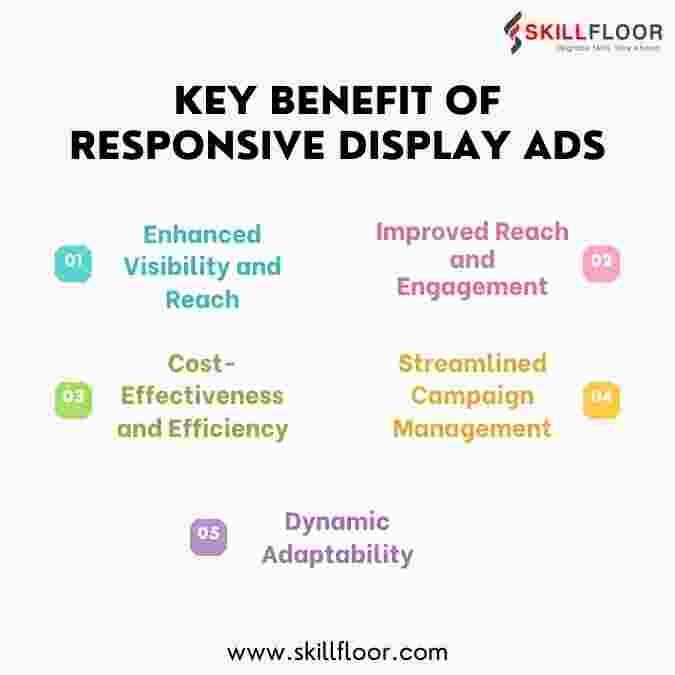What's a Key Benefit Of Responsive Display Ads?
Explore the key benefits of responsive display ads, including flexibility in design, broader reach, cost-effectiveness, easy optimization, and enhanced targeting capabilities

Effective advertising is crucial for firms in modern times, as having an online presence is essential. Responsive display advertisements are one of the most effective ways to reach and interact with target audiences out of all the advertising possibilities available. We explore the main advantages of responsive display ads in this blog article and show you how they might revolutionize your advertising approach.
Google Ads offers responsive display ads, a flexible ad type that automatically changes to meet available ad spaces throughout the Google Display Network in terms of size, style, and format. With the millions of websites, applications, and videos that make up this network, advertisers may reach a large audience with their message.
Responsive display ads have transformed how businesses advertise their products and services online. Unlike traditional static advertising, responsive display ads adapt their size, style, and format to fit the available ad space on a variety of websites and apps. This versatility has several benefits, including increased effectiveness of advertising initiatives. Let's look at the primary advantages of using responsive display ads.
Key Benefit
-
Enhanced Visibility and Reach: Responsive display advertising enhances visibility across a wide range of devices and screen sizes. These ads look great on computers, laptops, tablets, and smartphones because they adjust to multiple resolutions and layouts automatically. This comprehensive interoperability broadens reach, allowing firms to communicate with a varied audience across multiple internet channels.
-
Improved Reach and Engagement: The dynamic nature of responsive display adverts promotes better user interaction. These advertisements tailor their content and format to the circumstances and preferences of each viewer, improving relevance and resonance. As a result, people are more inclined to interact with these advertisements, resulting in higher click-through rates and increased traffic to the advertiser's website.
-
Cost-Effectiveness and Efficiency: Responsive display ads simplify the advertising process by eliminating the need to develop separate ads for different devices and screen sizes. With a single set of assets, advertisers can efficiently target their audience across many channels, saving time and costs. Furthermore, enhanced performance and engagement metrics linked with responsive advertisements result in a higher return on investment (ROI) for advertisers.
-
Streamlined Campaign Management: Responsive display advertisements can make campaign administration easier by eliminating the need for manual modifications and optimizations. Instead of producing many ad variations for different placements and formats, advertisers can produce a single responsive ad and trust Google's machine-learning algorithms to handle the rest. This automation not only saves time and resources, but also ensures that ads are constantly optimized for effectiveness.
-
Dynamic Adaptability: One of the most significant advantages of responsive display advertisements is their ability to adjust dynamically. These ads use machine learning algorithms to evaluate the success of various ad components, such as headlines, images, and descriptions, and optimize them for optimum impact. Responsive display advertisements may give unique, relevant content to each viewer while continuously testing and refining ad elements in real-time, increasing the likelihood of engagement and conversion.

Best Practices for Creating Responsive Display Ads
1. Using High-Quality Images and Videos
Visual content is the foundation of any successful advertising campaign, and this is particularly true for responsive display ads. When creating advertisements, it's critical to use high-quality photographs and videos that not only capture attention but also align with your brand's identity and messaging. High-quality pictures can dramatically improve the overall impact of your advertisement by attracting the audience's attention and encouraging them to interact with your material. Whether you're showing product features, customer testimonials, or simply communicating your brand's values, investing in professional-quality images may make a big impact on how your advertising is seen.
2. Writing Effective Ad Copy
While images are unquestionably crucial, the written component of your ad is as critical for increasing engagement and conversions. A compelling ad copy should be brief, persuasive, and clearly express the value proposition of your product or service. Use eye-catching headlines to entice consumers, followed by brief body text emphasizing the benefits of your business. Focus on meeting your target audience's requirements and desires, and include a strong call-to-action that encourages them to take the next step, whether it's making a purchase, signing up for a newsletter, or visiting your website. Effective ad language should address your audience's pain areas and goals, persuading them to take action.
3. Testing and iteration
Continuous testing and iteration are critical components of any successful advertising plan, including responsive display ads. To improve the success of your advertising, experiment with various ad elements such as headlines, pictures, and calls to action to determine what connects most with your target demographic. A/B testing allows you to compare the performance of several ad variations and identify which features generate the most engagement and conversions. By evaluating performance indicators regularly and improving your ad content in response to user feedback, you can continuously increase the effectiveness of your responsive display ads and maximize their influence on your advertising objectives.
How do responsive display ads differ from traditional display ads?
Responsive display advertisements provide a more flexible and automated approach. Advertisers provide a variety of assets, including headlines, descriptions, photos, and logos, and Google advertising automatically evaluates and modifies the advertising to match various ad locations throughout the Display Network. This adaptability not only saves time but also improves performance by displaying more effective ad combinations to various audiences. Using machine learning to test different asset combinations allows these ads to improve over time, potentially increasing click-through rates and overall campaign efficacy. Additionally, responsive display advertisements offer dynamic retargeting, which dynamically personalizes ads based on the products or services viewers have previously visited on a website, increasing the ads' relevancy and efficacy.
Traditional display advertisements, also known as standard display ads, require the advertiser to design and upload static pictures in certain sizes. These ads do not change or adjust in format and must be tailored to each exact size accessible on the Google Display Network. While this may limit flexibility, it does provide advertisers more control over how their ads appear, which is important for brand consistency and targeted messaging. However, the manual process of designing and testing each ad variant can be time-consuming and may not result in the same level of optimization as responsive display advertising, which is algorithmically driven. This makes traditional display ads suitable for campaigns where specific designs and placements are critical, but less adaptive to the varying contexts in which they might appear.
Responsive display ads provide numerous benefits that might revolutionize your advertising approach and generate significant results. Responsive display advertisements have numerous advantages, including enhanced reach and visibility, improved performance, and cost-effectiveness. Embrace the power of responsive advertising and unleash new prospects for success in the digital space.




























































